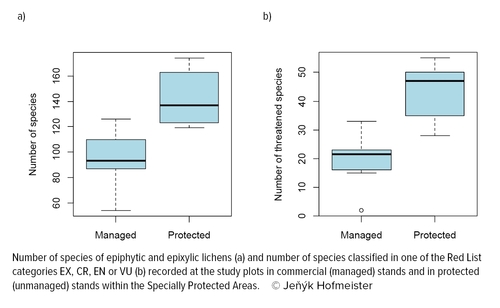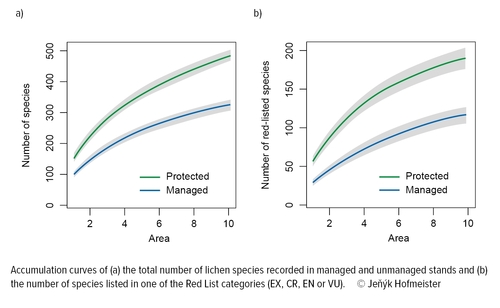Nature Conservation 2025 — 31. 7. 2025 — Nature and Landscape Management — Print article in pdf
Importance of Spatiotemporal Continuity of Forest Habitats for Forest Biodiversity
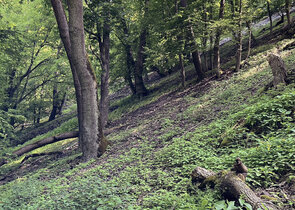
Changes in the woody plant species composition and simplification of forest habitat structure are the accompanying features of forest management in the Czech Republic over the last two centuries. In addition to forest management itself, the reduction in the size of habitats that are little affected by human activity is also related to the overall human use of the landscape.
It is generally considered that the small size of forest habitats, the development of which is primarily driven by natural forces, and the interconnectedness of such habitats in the landscape are among the significant drivers of the decline in the biodiversity of the organisms associated with them. However, relatively little has been known about which characteristics make less human-influenced forest habitats attractive to a particular group of forest organisms.
If we want to effectively protect and conserve the biodiversity of forest habitats, we need to identify which forest habitat features are key to biodiversity and focus on protecting and conserving them. There are a number of questions that can be asked about the characteristics of forest habitats in relation to biodiversity, and they relate to different spatial scales. To begin with the most commonly studied question: Is the main reason for the attractiveness of forest habitats less affected by humans for forest biodiversity due to their higher structural heterogeneity, which can be realistically measured and compared at the level of specific sites? In other words, is biodiversity a reflection of structural diversity? The question is based on the assumption that greater heterogeneity of natural conditions and individual (micro)habitats allows for the coexistence of more species-rich communities of organisms.
But is not it rather the total size of forest habitats at the landscape level that is crucial from the point of view of forest biodiversity? Habitat size can also be realistically measured and therefore its importance verified. Similarly, we can assume that as the duration of favourable conditions increases, the habitat is more likely to be colonised by new species that are suited to the conditions. That is, with increasing temporal continuity, the species diversity of the habitat is likely to increase as a result of successive colonisation by new species. In the extreme case, the characteristics of the structure and the degree of preservation of the forest stand at the local and landscape scales could represent ‘only’ the necessary conditions demonstrating the potential of the habitat for the existence of forest species-rich communities but their actual presence would be governed by the time (temporal continuity) over which these conditions persist. Is it not the temporal continuity of a given habitat that determines the presence and absence of species to the greatest extent?
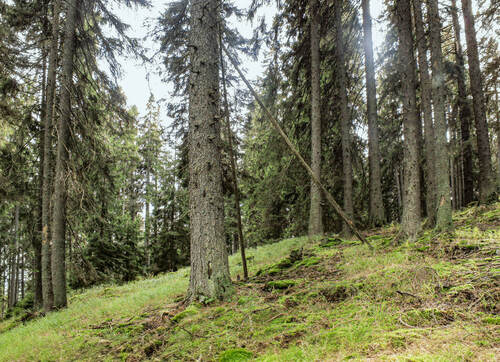
Mountain reed-grass spruce forest in the Boubínský prales/Boubín Primeval Forest National Nature Reserve. © Jeňýk Hofmesiter
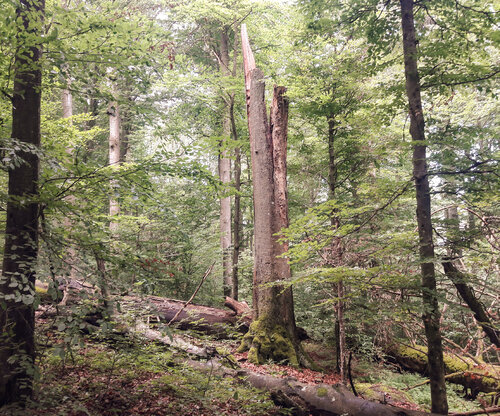
Flower-rich beech forest with a long-term continuing development undisturbed by forest management in the Žofínský prales/Žofín Primeval Forest. © Jeňýk Hofmesiter
Searching for answers to the questions
The authors tried to answer all the above questions by investigating the species composition of epiphytic and epixylic lichen communities in relation to the structure and spatiotemporal continuity of forest habitats at ten sites with remarkable lichen communities in the Czech Republic (Table 1). The survey was conducted in regions with lower levels of past air pollution, as this effect on lichen species diversity has been persisting. At each site selected, two 1 ha study plots were chosen to cover a comparable and as wide a gradient of natural conditions as possible, with one study plot located within a Specially Protected Area (and not managed for long term forestry) and the other located in a managed forest with a similar species composition and as old as possible. The sites within the Specially Protected Areas are the best-preserved fragments of forest habitats potentially important for epiphytic and epixylic lichens - and, in a broader sense, forest biodiversity in general (Table 1). An inventory of epiphytic and epicyclic lichen species on all substrates within 2 m of the ground surface was carried out at all sites. In addition, an inventory of microhabitats, species composition and structure of trees and dead wood was carried out there. Microhabitats were mapped using existing microhabitat catalogues, but these were modified and supplemented with some missing microhabitat types specific to epiphytic and epicyclic lichens.
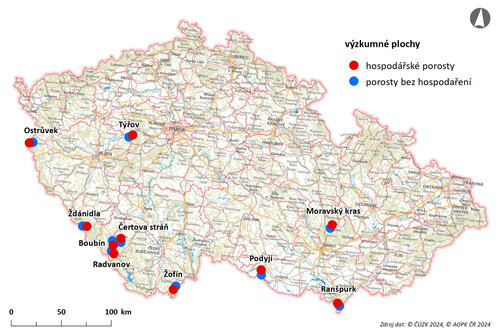
Location of study plots within the Czech Republic. © Jeňýk Hofmeister
Data source: © State Administration of Land Surveying and Cadastre 2024, Nature Conservation Agency of the Czech Republic 2024
Epiphytic and epixylic lichens display several favourable characteristics making them a suitable model group for this research. This is a relatively large group of species, with about 700 species occurring in the whole country. A significant part of the species diversity consists of taxa with the ability to indicate preserved forest habitats, inter alia, little affected by human activities. A significant part of the species is rare to very rare, and we have a fairly good knowledge of the distribution of these rare species in the Czech Republic. From the point of view of the mapping itself, it is an advantage that one visit is sufficient to determine the species diversity at a site, during which a group of experienced lichenologists will record most of the species. In addition, species can be easily recorded during the inventory, including the link to the specific microhabitat in which they occur, being specific to many species.
The aim of the research was to determine the importance of individual potentially important forest habitat features for the species diversity in epiphytic and epixylic lichens. A summary of these characteristics is presented in Table 2. The real significance of the influence of these characteristics on species diversity was evaluated using the data gathered using linear regression models (GLS - generalized least squares). In these models, elevation and the category separating habitats in managed and protected forest (without management) were included as additional explanatory variables.
What answers did the research provide?
A total of 513 species of epiphytic and epixylic lichens were found in 20 study plots (with a total area of 20 ha), representing a significant part of the total species diversity in the Czech Republic. As expected, both the total number of epiphytic and epixylic lichen species recorded and the presence of threatened species were significantly higher in protected forests compared to nearby habitats in commercial stands (see the figures right on this page). A total of 482 species were found in study plots in protected forests (see the figures right on this page), while 323 species were recorded in commercial forests. More than one third of the species (191) were found exclusively in study plots in protected forests (see the figures right on this page), while only 32 species were recorded exclusively in commercial growths. Similar differences between protected and managed forests were also found in the representation of endangered lichen species. While species recorded only in study plots in protected forests contributed significantly to the overall species richness of all sites, the contribution of study plots in commercial forests was generally much lower. It is worth noting that, despite the above differences between protected and commercially managed forests, the vast majority of sites surveyed in managed forests can be considered to be above average in terms of both total lichen abundance and the occurrence of threatened species, at least compared to ‘normal’ commercially managed forests in the Czech Republic.
Number of species of epiphytic and epixylic lichens (a) and number of species classified in one of the Red List categories EX, CR, EN or VU (b) recorded at the study plots in commercial (managed) stands and in protected (unmanaged) stands within the Specially Protected Areas. © Jeňýk Hofmeister
Accumulation curves of (a) the total number of lichen species recorded in managed and unmanaged stands and (b) the number of species listed in one of the Red List categories (EX, CR, EN or VU). © Jeňýk Hofmeister
Table 1 Characteristics of study plots © Jeňýk Hofmeister
|
Study plot |
|
Habitat |
Elevation |
Protected since |
Number of lichen species |
Number of red-listed species |
|
|
|
|
(m.a.s.l.) |
(year) |
|
|
|
Boubín |
BO |
Mountain reed-grass spruce forest |
1270 |
1958 |
119 |
35 |
|
|
|
Mountain reed-grass spruce forest |
1250 |
|
110 |
23 |
|
Čertova stěna/Devil’s Wall |
CS |
Acidiplilous beech forest |
725 |
1992 |
159 |
50 |
|
|
|
Acidiplhilous beech forest |
720 |
|
87 |
21 |
|
Moravský kras/Moravian Karst |
MK |
Scree forest |
370 |
1956 |
123 |
40 |
|
|
|
Scree forest |
470 |
|
91 |
18 |
|
Ostrůvek/Islet |
OS |
Acidiphilous beech forest |
750 |
1973 |
133 |
28 |
|
|
|
Cultural spruce forest |
780 |
|
54 |
2 |
|
Podyjí/ThayaRiver Basin |
PO |
Scree forest |
390 |
1950 |
174 |
50 |
|
|
|
Scree forest |
395 |
|
126 |
33 |
|
Radvanov |
RD |
Flower-rich beech forest |
895 |
1991 |
141 |
55 |
|
|
|
Flower-rich beech forest |
820 |
|
105 |
24 |
|
Ranšpurk |
RN |
Hardwood floodplain forest |
180 |
1949 |
122 |
34 |
|
|
|
Hardwood flodplain forest |
170 |
|
73 |
15 |
|
Týřov |
TY |
Scree forest |
320 |
1933 |
166 |
47 |
|
|
|
Flower-rich beech forest |
340 |
|
93 |
16 |
|
Ždánidla |
ZD |
Acidiphilous beech forest |
1180 |
1950 |
163 |
54 |
|
|
|
Acidiphilous beech forest |
1130 |
|
118 |
22 |
|
Žofín |
ZF |
Flower-rich beech forest |
770 |
1838 |
127 |
47 |
|
|
|
Flower-rich beech forest |
840 |
|
93 |
22 |
Thus, we found relatively significant differences in lichen species diversity between study plots in (mostly) similar forest habitat types differing in the degree of protection/conservation. Do these differences in species diversity correspond to differences in forest habitat characteristics that we considered potentially important? Mostly yes, but we need to look at the results more closely. Variability in microhabitat types emerged as a very significant positive predictor of lichen species diversity. As the variability of microhabitats at a site increased, the number of lichen species and the number of threatened species found increased. Frequency of microhabitat occurrence was also a significant predictor of lichen species diversity, but in a negative sense. The explanation for the pattern is usually higher tree densities in commercial forests with common microhabitat types, but their abundance does not increase the lichen species diversity. However, the negative effect of microhabitat frequency on biodiversity needs to be interpreted within the limits of the study. Clearly, if we were to include not only the oldest stands but also younger growths and young growths where trees with microhabitats are rare, a conclusive negative relationship would most likely not be found.
Table 2 The predicted and demonstrated importance of individual potentially significant forest habitat features for the species diversity of epiphytic and epixylic lichens; the magnitude of the predicted (positive) indicator potential is expressed by one or two ‘+’ symbols: + indicates a positive effect, ++ indicates a strong positive effect. An unconfirmed or ambiguous effect is indicated by the symbol ‘(+)’, the absence of a positive effect is indicated by the symbol ‘x’. © Jeňýk Hofmeister
|
Habitat characteristics |
Predicted effect |
Demonstrated effect |
|
Stand structural variability |
+ |
(+) |
|
Presence of big (old) trees |
+ |
+ |
|
Presence of dead wood big pieces |
+ |
(+) |
|
Presence of big (old) trees with microhabitats |
++ |
+ |
|
Presence of dead wood big pieces with microhabitats |
++ |
+ |
|
Microhabitat variability |
++ |
++ |
|
Microhabitat frequency |
++ |
x |
|
Close to nature forest habitat area |
+ |
+ |
Other characteristics related to forest habitat structure were not systematically applied in the models. Microhabitat heterogeneity seems to ideally capture the overall heterogeneity of habitat conditions related to tree species composition, age, size, etc., which in total determine lichen species diversity. Consequently, mapping microhabitat heterogeneity can be used as an indicator of the particular habitat potential for species diversity of epiphytic and epixylic lichens. However, it was not only forest structure characteristics expressed by microhabitat heterogeneity that influenced lichen species diversity there.
The species diversity in lichens increased with the extent of natural forest habitats in the vicinity of the study area. The model results were best when considering the area surrounding the study plot within 1 km, which represents an area of approx. 300 hectares. However, larger distances could not be tested without inaccuracies, as some of the areas so defined already extended beyond the Czech Republic’s borders and lacked relevant information. Alternative testing using the CORINE map layer also showed the best results for the area surroundings up to a distance of 1 km, but the natural habitat coverage is only approximate in this case. In any case, it can also be concluded based on these results that a larger extent of natural habitats in the vicinity of the study areas contributes positively to their species diversity. At the same time, however, it is important to note that the Specially Protected Areas cover at least 300 hectares of natural forest habitats only at two sites in national parks; in all other cases, the size of the Specially Protected Area itself is smaller - and often significantly so.
The last variable with a systematically significant effect on lichen species diversity was the category separating protected and commercial forests. The belonging of an area to protected forests was itself another characteristic predicting higher species richness of epiphytic and epixylic lichen communities and more frequent presence of endangered species. This means that part of the variation in species diversity between the study study plots cannot be explained by differences in stand structure (or at least not by those we studied) or differences in the extent of natural forest habitats in their surroundings. Even in real terms, the structure and species composition of old commercial stands at many sites did not differ markedly from those in Specially Protected Areas. How might protected and commercial forests differ, and have we not captured this by differences in the structure and quality of forest habitats at a local or landscape level? If we think about how protected and commercial forests differ further, it is the difference in the duration of their development since the last management intervention that is implied by their definition. Although the duration of undisturbed development varies considerably both in the individual protected forests (see Table 1) and to a lesser extent in the adjacent managed forests, it can nevertheless be stated that the forests within the Specially Protected Areas display a much longer continuity of spontaneous development without direct management intervention at each site. We conclude that this variable highlights the importance of temporal continuity in non-human-driven forest habitat development for lichen species diversity. This significance may not be observable (measurable) by forest habitat characteristics, although temporal continuity undoubtedly positively influences, among other measurable characteristics of forest structure, including microhabitat heterogeneity, the crucial importance of which our study also showed.
What does this imply for the protection of forest habitats?
In this study we have shown that the exceptional species diversity in epiphytic and epixylic lichen communities at the study sites and particularly the Specially Protected Areas is influenced by the heterogeneity and conservation of forest habitats at the local and landscape level, as well as by the time elapsed since the last management intervention. Thus, in addition to the variability of site-specific conditions, the spatial and temporal continuity of these habitats is of major importance for the lichen species diversity. This is threatened, even in many of the study sites, by the continued commercial forest management interventions in the immediate vicinity of the Specially Protected Areas, most of which are currently almost completely insufficient and should, according to the results of this study, reached at least 300 hectares in size. What opportunities do we have to strengthen and enhance the spatiotemporal continuity of forest habitats? Can we increase the area of strictly protected areas where forestry is excluded? At present, the area of strictly protected areas can be estimated at less than 1.5% of the Czech Republic’s territory. This is very far from the target of strictly protecting at least 10% of the area set out in the EU Biodiversity Strategy for 2030 Bringing nature back into our lives. In the Strategy, the target is justified just by the very facts highlighted in the study. But do we even have suitable habitats whose protection can strengthen the spatial and temporal continuity of natural forest habitats?
Currently, the most widespread types of natural forest habitats in the Czech Republic are acidophilous and flower-rich beech forests covering almost 9% of the forest area. According to potential vegetation concept, beech forests should form the majority of the vegetation cover in the Czech Republic, which is far from being the case at present. Although a substantial part of the beech forest coverage is located within various Specially Protected Area categories, the predominant area of these habitats is subject to standard forestry management. Thus, there are probably only two beech forest sites in the whole Czech Republic, namely the Jizerskohorské bučiny/Jizeara Mountains Beech Forests and part of the Východní Krušné hory/Eastern Ore Mountains Site of European Importance (SEI, pursuant to Act No. 114/1992 on Nature Conservation and Landscape Protection, as amended later, the term for Site of Community Importance, SCI, later Special Areas of Conservation, SAC, under the European Union’s Habitats Directive) EVL) where spontaneous development undisturbed by management interventions would be ensured on 300 hectares. However, beech stands make up a relatively large part of the commercial forests described as ‘over-aged’, as they are usually not worth harvesting due to their difficult accessibility. We therefore have a unique opportunity to take advantage of the situation and protect the stands. To a large extent, the same solution can be applied to the other types of natural forest habitats included in this study, provided that the protection of species diversity in other groups of organisms does not require active management of a particular habitat.
Acknowledgements
The research was supported by the Technology Agency of the Czech Republic through project SS01010270. Detailed results, including an inventory of species found and relevant literature, are presented in Hofmeister et al., 2024. Hot-spots of epiphytic and epixylic lichens in fragmented temperate forests are underpinned by microhabitat heterogeneity and spatiotemporal habitat continuity. Biological Conservation 292, 110563. ■
- - - -
Cover photo: Scree forest with rich woody plant composition on a southern slope in the Oupořský potok/Oupoř Brook in the Týřov National Nature Reserve. © Jeňýk Hofmesiter
- - - -
The list of references is attached to the online version of the article at www.casopis.ochranaprirody.cz


